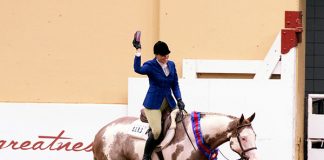 Teaching your horse to lope off on the correct lead can be achieved in three simple steps: the set-up, the cue and the release. World-champion reining trainer Casey Deary, of Deary Performance Horses in Weatherford, Texas, explains how.
Teaching your horse to lope off on the correct lead can be achieved in three simple steps: the set-up, the cue and the release. World-champion reining trainer Casey Deary, of Deary Performance Horses in Weatherford, Texas, explains how.
Step 1: The Set-Up
“If I am going to lope off to the left, I want the horse’s right rear leg to be forward and underneath him, or on the way forward and underneath him, before I ask him to lope,” Deary says.
When loping off from a standstill, Deary will allow his horse to take two or three steps to make sure the horse is in a good frame to lope off correctly. “However, by the time I’m ready to show, my horses will lope off from a standstill,” he says.
Step 2: The Cue
When Deary teaches a young horse to lope for the first time, he works in a large circle and uses his outside leg to push the horse into the lope. “If I want to lope off to the left, I will trot the horse in a circle to the left and push with my outside leg until the horse picks up the correct lead,” Deary explains. “If he picks up the incorrect lead, then I will break him down to the trot and try again.”
Step 3: The Release
Once the horse understands how to lope and which lead to pick up, Deary will refine the cue. “I will put my outside leg on the horse to ask for the lope, but when he tries to lope off, I will hold him back. Then, when I am ready to lope, I will cluck, release the horse, and let him lope off.”
The horse learns that, when Deary pushes with his outside leg, he is to move his hip away from Deary’s leg but wait for the verbal cue to lope off. “The cue to lope is me clucking,” he says.
Loping Don’ts
Don’t turn your horse’s nose to the outside. “I will only do that on a young horse the first two or three times I ask him to lope, until he understands what I am asking,” Deary says. “But I sure don’t want to make a habit out of it. I want the horse looking to the inside when I lope off.”
Don’t lean in to influence your horse to pick up a particular lead. “On a younger horse, I may lean forward a little bit, but on a broke horse I expect the horse to do all the work,” Deary says. “When I put my leg on the horse and cluck, I expect him to pick up the correct lead without me having to push or lean.
Further Reading
Question of the Week: Lope Leads
Video: Lope Leads with John Lyons
Walk to Lope Transitions







Love it! I’m an Improver rider and when I asked my (ex) trainer how to help the horse when asking for lope, she said “Just ask. She’ll work it out.” I knew it had to be something to do with hind feet placement but couldn’t quite ‘get it’ on my own. Thank you very much for this article – it is now ingrained in my head – and, oh, yes, I’m going it alone!
another thing is that when you’re counter cantering, it should feel the same as the correct lead, because your horse should be wiling, and well rounded/driven up. trust me, it’s hard to master. haha. my horse, Dayzi can do it pretty well now and she feels almost the same both ways. it took FOREVER to get her that way!
Good to know though I’m not sure why pulling the head to the outside would help.
informative ,helpful gives more than most trainers
That’s interesting.